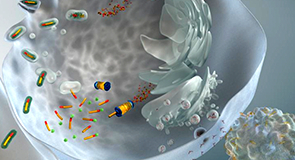Axalimogene Filolisbac (ADXS-HPV)
Axalimogene Filolisbac (ADXS-HPV) Clinical Program for Human Papilloma Virus (HPV)-Associated Cancers
Cervical Cancer:
Advaxis has completed a randomized phase II clinical trial evaluating axalimogene filolisbac +/– cisplatin in patients (n = 110) with recurrent cervical cancer in India. Overall survival rates achieved in this study relative to historical controls treated with standard therapy prompted the US cooperative Gynecologic Oncology Group (GOG) to initiate a 2-stage investigation of axalimogene filolisbac monotherapy in a similar recurrent cervical cancer population. In January 2015, first results from the GOG-0265 study indicated that stage 1 of the phase II open-label clinical study (n = 29 patients) met the predetermined safety and 12-month survival criteria required to proceed into the second stage of patient enrollment. Additionally, Advaxis and the GOG Foundation, Inc. have entered into a second clinical trial agreement to conduct an adequate and well-controlled phase III clinical trial of concurrent chemotherapy and radiation therapy (CCRT) compared to CCRT combined with axalimogene filolisbac in women diagnosed with high-risk, locally advanced cervical cancer. Advaxis intends to request a Special Protocol Assessment from the US Food and Drug Administration (FDA) prior to commencing this collaborative study.
Axalimogene filolisbac is being evaluated in 3 additional clinical trials for HPV-associated cervical cancer either alone at higher doses than those utilized to date, or in combination with other immunotherapeutics (MedImmune’s durvalumab and Incyte’s epacadostat).
Head and Neck Cancer:
Axalimogene filolisbac is under evaluation in 2 clinical trials for HPV-associated head and neck cancer (HNC). The first is a “window of opportunity” phase I-II study initiated at the Icahn School of Medicine at Mount Sinai investigating the effects of the immunotherapy in patients newly diagnosed with HPV-positive HNC, prior to receiving any chemotherapy or radiation. The second study is being conducted in combination with MedImmune’s durvalumab, and will enroll patients with either HPV-associated advanced head and neck or cervical cancer.
Anal Cancer:
The axalimogene filolisbac development program in anal cancer includes an ongoing phase I-II study assessing the safety and effectiveness of the immunotherapy administered with concurrent standard chemotherapy and radiation treatment. The trial is sponsored and coordinated by Brown University Oncology Research Group. Although a relatively rare tumor, virtually all cases of squamous cell cancer of the anus are caused by HPV infection. The study will seek to enroll 25 patients.
Axalimogene filolisbac has received Orphan Drug Designation from the FDA for cervical cancer, HNC, and anal cancer.
Axalimogene filolisbac is an immunotherapy that is under investigation for targeting cells that have been transformed into dysplastic and malignant tissues by HPV. It is hypothesized that eliminating these cells can eliminate the dysplasia or malignancy. Axalimogene filolisbac is being researched for its potential to gain access to antigen-presenting cells and direct them to generate a cellular immune response to HPV E7. Advaxis is investigating whether the resulting cytotoxic T cells can infiltrate and attack tumors. The Advaxis Lm Technology™ is also being researched for inhibition of T-regulatory cells (Tregs) and myeloid-derived suppressor cells (MDSCs) within tumors without causing autoimmunity.
HPV as a Therapeutic Target:
In 2009, the Centers for Disease Control reported that about 45% of women aged 20 to 24 had HPV. Oncogenic HPV has a causal role in nearly all cervical cancers and in many vulvar, vaginal, penile, anal, and oropharyngeal cancers. Two vaccines (bivalent and quadrivalent) are available to protect against HPV types 16 and 18, which are responsible for 70% of cervical cancers. HPV 16 also is the most common HPV type found in the other 5 cancers often associated with HPV. During 2004–2008, an average of 33,369 HPV-associated cancers were diagnosed annually (rate: 10.8 per 100,000 population), including 12,080 among males (8.1 per 100,000) and 21,290 among females (13.2). (http://www.cdc.gov)
The American Cancer Society estimates that in 2015 there will be about 12,900 newly diagnosed cervical cancer cases, 45,780 oropharyngeal cancers (of which 72% are believed to be associated with HPV infection).


